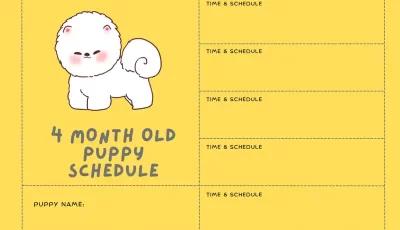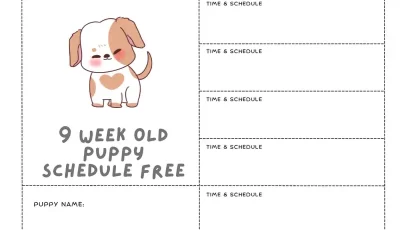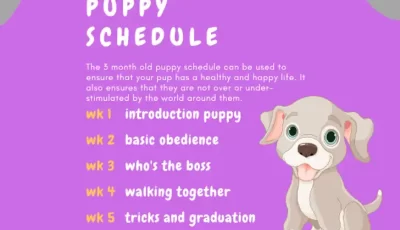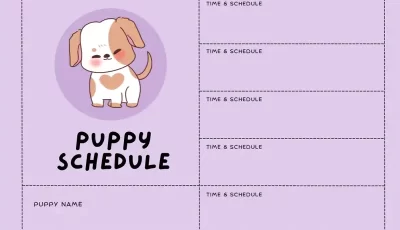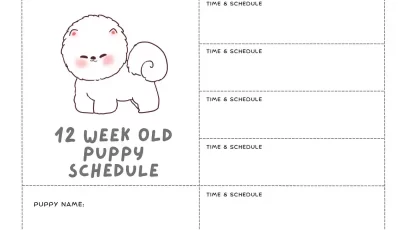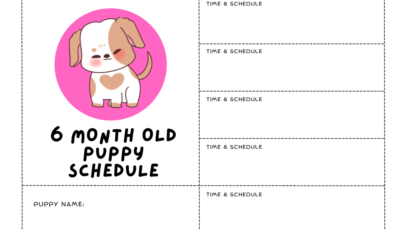Puppy Schedule For Working Parents – As a working parent, caring for a puppy can be challenging. Finding the puppy schedule for working parents can seem overwhelming, but it can be a manageable task with a good schedule.
This article will concern the essential puppy care routines that working parents should follow. A comprehensive guide to making a schedule that fits your busy lifestyle, including potty training, feeding, exercise, sleeping, grooming, playtime, and socialization.
Puppy Potty Training Schedule for Working Parents
According to the American Kennel Club, puppies can usually handle their bladder for an hour monthly during their period. This means that a two-month-old puppy may require to go potty every two hours, while a six-month-old puppy can wait up to six hours. However, it’s crucial to remember that every puppy is other; some may need more frequent potty breaks than others.
Choose a designated potty area.
The first stage is to select a designated potty area outdoors and consistently bring your puppy to that area. This will let them associate that area with potty time and make learning where to go more leisurely.
Establish a schedule
Next, you should establish a plan when the puppy requires to go outdoors. This can include first thing in the morning, after feeds, after naps, and before bedtime.
According to the American Society for the Prevention of Cruelty to Animals, puppies may require to go outdoors as often as every 30 minutes to an hour during the early stages of potty exercise.
Positive reinforcement
It is also crucial. Praise and reward your puppy every time they go potty outside, and avoid punishing or scolding them for accidents inside the house.
According to the Humane Society of the United States, positive reinforcement is the most useful method to train your puppy and make a powerful bond between you and your puppy.
Patient and consistent
Being patient and consistent with potty training your puppy is critical. Puppies can take a few weeks to several months to be fully trained. Maintaining consistency with positive reinforcement will allow growth; eventually, your pup should understand where and when they can go outdoors.
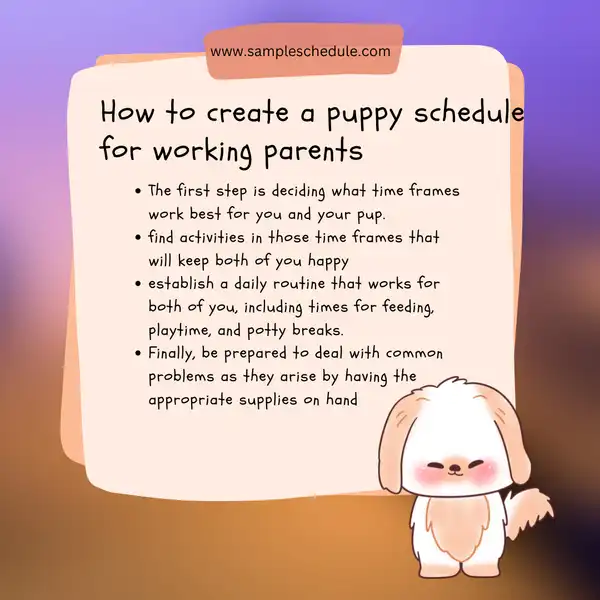
How to create a puppy schedule for working parents
Read Also: Best Tips for Creating 4 Month Old Puppy Schedule
Puppy Feeding Schedule for Busy Working Parents
Feeding your puppy on a schedule is also crucial. The type of food and amount will depend on your puppy’s age, size, and breed.
As per the American Society for the Prevention of Cruelty to Animals (ASPCA), puppies should be fed three to four times daily until they are six months old. Subsequently, it is recommended that you switch over to offering two meals in a day. Ensure fresh water is always available, and give them only what is necessary.
Busy working parents must create a regular puppy feeding schedule to ensure their pup’s healthy growth and development. This article will provide an essential guide on how best to do this.
Comprehending your puppy’s dietary requirements on age, breed, and weight is vital. A nutritious meal should comprise protein, carbohydrates, fats, vitamins, and minerals. Confer with a veterinarian to select the appropriate kind and quantity of food.
Once you have identified the correct nutrition for your pup, devise a feeding regimen that accommodates your daily schedule. It is best to offer puppies three or four mini meals daily to keep them nourished and healthy. Due to long working hours, an automated feeder can distribute meals at regular prearranged times.
Establishing a routine at mealtime is vital when caring for your puppy. A consistent schedule can help them understand that certain parts of the day are associated with being provided and will make it less likely they will beg you for food outside mealtimes. Remember to provide your puppy with fresh water daily.
Monitoring your puppy’s weight and altering the feeding schedule in response is essential. Overfeeding can result in obesity and other health problems; conversely, underfeeding may lead to malnutrition and impede development.
Creating the ideal puppy feeding schedule for employed parents requires considering their pup’s dietary needs and work timetable. It is advised to consult one’s veterinarian, set up a routine, and monitor the pet’s weight to guarantee wellness and satisfaction.
How to Develop a Fun and Effective Puppy Exercise Schedule for Busy Working Parents
As a busy working parent, finding the time to exercise your puppy can be difficult. However, regular exercise is vital for your puppy’s physical and mental health. In this section, we will provide a guide on how to develop a fun and effective puppy exercise schedule for busy working parents.
Firstly, it is essential to understand your puppy’s exercise requirements based on age, species, and energy. Canines require a combination of both physical and mental stimuli to stay fit and comfortable. Consult your veterinarian to determine the appropriate amount and type of exercise for your puppy.
Once you have determined the right type of exercise for your puppy, create a schedule that fits your work schedule. Ideally, puppies should exercise at least 30 minutes daily, but this can differ depending on their period and species. Consider breaking up their exercise routine into shorter sessions throughout the day, such as a quick hike in the morning and a play session in the evening.
In addition to traditional exercises, such as walks and playtime, incorporate mental stimulation activities into your puppy’s routine. This can include puzzle toys, training exercises, and interactive games that challenge your puppy’s mind and keep them entertained.
Remember to prioritize safety during your puppy’s exercise routine. Avoid exercise during extreme weather conditions, ensure your puppy is wearing the appropriate gear, such as a leash and collar, and monitor their behavior during exercise to prevent injury or exhaustion.
Developing a fun and effective puppy exercise schedule for busy working parents requires careful consideration of your puppy’s individual needs and your work schedule. Consult with your veterinarian, incorporate physical and mental stimulation, and prioritize safety to confirm your puppy stays fit and comfortable.
Creating the Ideal Puppy Sleeping Schedule for Working Parents
Puppies require a significant sleep to keep their physical and mental growth. They should sleep between 12-14 hours per day. However, your puppy’s sleep amount may vary based on age, breed, and exercise level.
To create an ideal sleeping schedule for your puppy, consider the following factors:
- Age: Puppies under six months old may require more rest than adult dogs.
- Breed: Certain breeds, such as the Bulldog, may require more sleep than others.
- Activity Level: Puppies more energetic during the day may require more rest at night.
Once you have considered these factors, you can create a sleeping schedule that works for you and your puppy. Consider establishing a sleep schedule that includes a period of playtime or exercise followed by a calming activity such as reading or watching television.
It is vital to select a consistent sleeping schedule. This can assist in regulating their sleep cycle and prevent disruptions to their rest. Additionally, confirm that your puppy has a cozy and safe sleeping space.
Avoid giving your puppy directly before sleep, as this can cause disruptions to their sleep. Also, avoid allowing your puppy to nap for long periods during the day, as this can disrupt their bedtime schedule at night.
Creating an ideal sleeping schedule for your puppy requires careful consideration of their age, breed, and activity level. Establish a consistent bedtime routine, deliver a cozy napping space, and avoid disruptions to their sleep cycle. With these tips, you can deliver your puppy reaches the rest they require to thrive.
Grooming Schedule for Working Parents
One of the primary advantages of grooming your puppy is maintaining its coat and skin health. Routine brushing and bathing can assist control of skin irritations, matting, and infections. Also, grooming lets you check your puppy’s skin for abnormalities, such as bumps or rashes.
When developing a grooming schedule for your puppy, consider the following factors:
- Breed: Different breeds have different grooming requirements. Long-haired breeds, such as the Shih Tzu or Poodle, need more routine grooming than short-haired breeds, such as the Beagle or Boxer.
- Age: Puppies require less grooming than adult dogs, but developing good grooming habits is essential early on.
- Coat Type: Puppies with thick or double coats, such as Huskies or Golden Retrievers, may need more frequent brushing to stop matting and tangling.
- Activity Level: Puppies who spend more time outdoors may require more frequent baths and grooming.
It’s essential to establish a consistent grooming routine for your puppy. Consider scheduling grooming sessions at least once weekly for brushing and bathing, with additional nail trimming and ear cleaning sessions as needed.
Grooming is a vital aspect of managing your puppy. It helps keep their coat and skin healthy, contains dental issues, and provides an opportunity to check for abnormalities. Consider your puppy’s breed, age, coat type, and exercise level when creating a grooming schedule. With these tips, you can guarantee that your puppy looks and feels their best.
Sources:
American Kennel Club. “How to Groom a Dog.” AKC.org, https://www.akc.org/expert-advice/health/how-to-groom-a-dog/.
Hill’s Pet Nutrition. “Grooming Your Puppy.” Hill’sPet.com,
How to Create a Fun and Safe Puppy Playtime Schedule for Working Parents
According to the American Society for the Prevention of Cruelty to Animals, puppies need socialization with different dogs, somebody, and experiences to evolve into well-adjusted adults. Scheduling playtime with other dogs, going for walks, or playing with toys can help keep your puppy entertained and happy.
The first step in creating a puppy playtime schedule is establishing a routine. Puppies thrive on consistency, so schedule playtime around the same time every day. Aim for at least 30 minutes of playtime, but you can increase the duration if your schedule allows it.
It’s necessary to deliver a safe and secure environment for your puppy to play in. Puppies are curious and energetic, so guarantee that any potential hazards are removed from the play area. This has small objects, sharp edges, and toxic substances.
Consider your puppy’s breed, age, and energy level when selecting play activities. For example, a high-energy breed, such as a Border Collie, may enjoy playing fetch or going on runs, while a low-energy breed, such as a Bulldog, may prefer more leisurely activities such as tug-of-war or belly rubs.
Integrating exercise into playtime is also an excellent method to stimulate your puppy’s mind and support good behavior. Exercises such as hide-and-seek or puzzle games can mentally stimulate your puppy’s problem-solving talents.
Finally, delivering plenty of positive reinforcement and recognition during playtime is vital. This reinforces good behavior and boosts your bond with your puppy.
Creating a fun and safe puppy playtime schedule for working parents requires establishing a routine, providing a secure environment, selecting appropriate activities, including exercise, and delivering positive reinforcement. With these suggestions, you can guarantee that your puppy stays healthy, happy, and engaged even with a busy schedule.
Socialization Schedule for Busy Working Parents
Socialization is also a critical element of puppy care. Socializing your puppy can allow control behavior problems and make them satisfied in other situations.
According to the American Kennel Club, socializing should include positively exposing them to additional individuals, locations, and adventures.
It typically occurs between three and 14 weeks of age. They are most open-minded to new adventures, individuals, and other creatures during this time. Forgetting to socialize can lead to fear, anxiety, and even aggression as they grow older.
Creating a socialization schedule involves telling them about other creatures and their needs safely and positively. This can include teaching them to new companions, bringing them to puppy gardens or training classes, and telling them about sights and sounds. It’s vital to create these occasions praising and rewarding the puppy, using charms and praise to support good behavior.
However, incorporating socialization into your daily routine can create it more manageable. For example, bringing your puppy on hikes or to the garden after work can provide valuable socialization opportunities while also allowing you to bond with your furry friend.
It’s also essential to enlist the help of family, friends, or an experienced dog trainer to assist with socialization. They can teach socialization techniques and support your puppy to advance dogs in a protected and managed habitat.
It is vital for its development and well-being. As a busy working parent, it may seem challenging, but it can be done with some effort and creativity. Telling your puppy about positive backgrounds and teaching them about new somebody, creatures, and conditions can support them to become well-adjusted and secure adult dogs.
Sources:
American Veterinary Society of Animal Behavior. “Position Statement on Puppy Socialization.” AVSAB.org, https://avsab.org/wp-content/uploads/2018/03/Puppy_Socialization_Position_Statement_Download_-_10-3-14.pdf.
Conclusion
Creating a puppy schedule for working parents can be a manageable task. By following a routine for potty training, feeding, exercise, sleeping, grooming, playtime, and socialization, you can support your furry friend to thrive. Always provide love, attention, and positive reinforcement; you’ll have a happy and healthy puppy.
